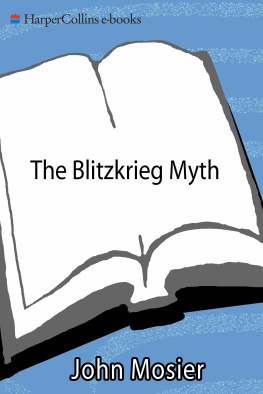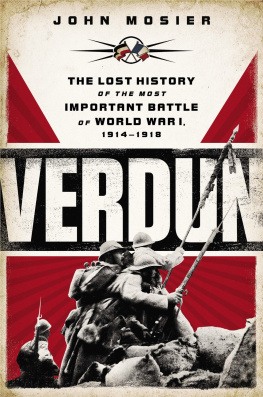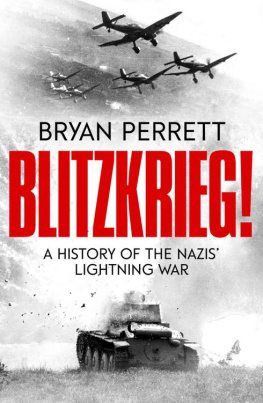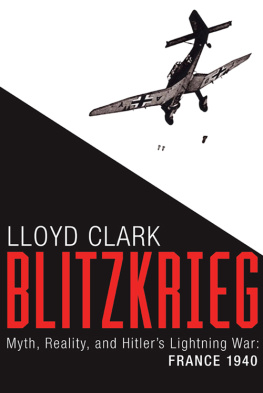John Mosier - The Blitzkrieg Myth
Here you can read online John Mosier - The Blitzkrieg Myth full text of the book (entire story) in english for free. Download pdf and epub, get meaning, cover and reviews about this ebook. year: 2020, publisher: HarperCollins, genre: History. Description of the work, (preface) as well as reviews are available. Best literature library LitArk.com created for fans of good reading and offers a wide selection of genres:
Romance novel
Science fiction
Adventure
Detective
Science
History
Home and family
Prose
Art
Politics
Computer
Non-fiction
Religion
Business
Children
Humor
Choose a favorite category and find really read worthwhile books. Enjoy immersion in the world of imagination, feel the emotions of the characters or learn something new for yourself, make an fascinating discovery.
- Book:The Blitzkrieg Myth
- Author:
- Publisher:HarperCollins
- Genre:
- Year:2020
- Rating:3 / 5
- Favourites:Add to favourites
- Your mark:
- 60
- 1
- 2
- 3
- 4
- 5
The Blitzkrieg Myth: summary, description and annotation
We offer to read an annotation, description, summary or preface (depends on what the author of the book "The Blitzkrieg Myth" wrote himself). If you haven't found the necessary information about the book — write in the comments, we will try to find it.
The Blitzkrieg Myth — read online for free the complete book (whole text) full work
Below is the text of the book, divided by pages. System saving the place of the last page read, allows you to conveniently read the book "The Blitzkrieg Myth" online for free, without having to search again every time where you left off. Put a bookmark, and you can go to the page where you finished reading at any time.
Font size:
Interval:
Bookmark:
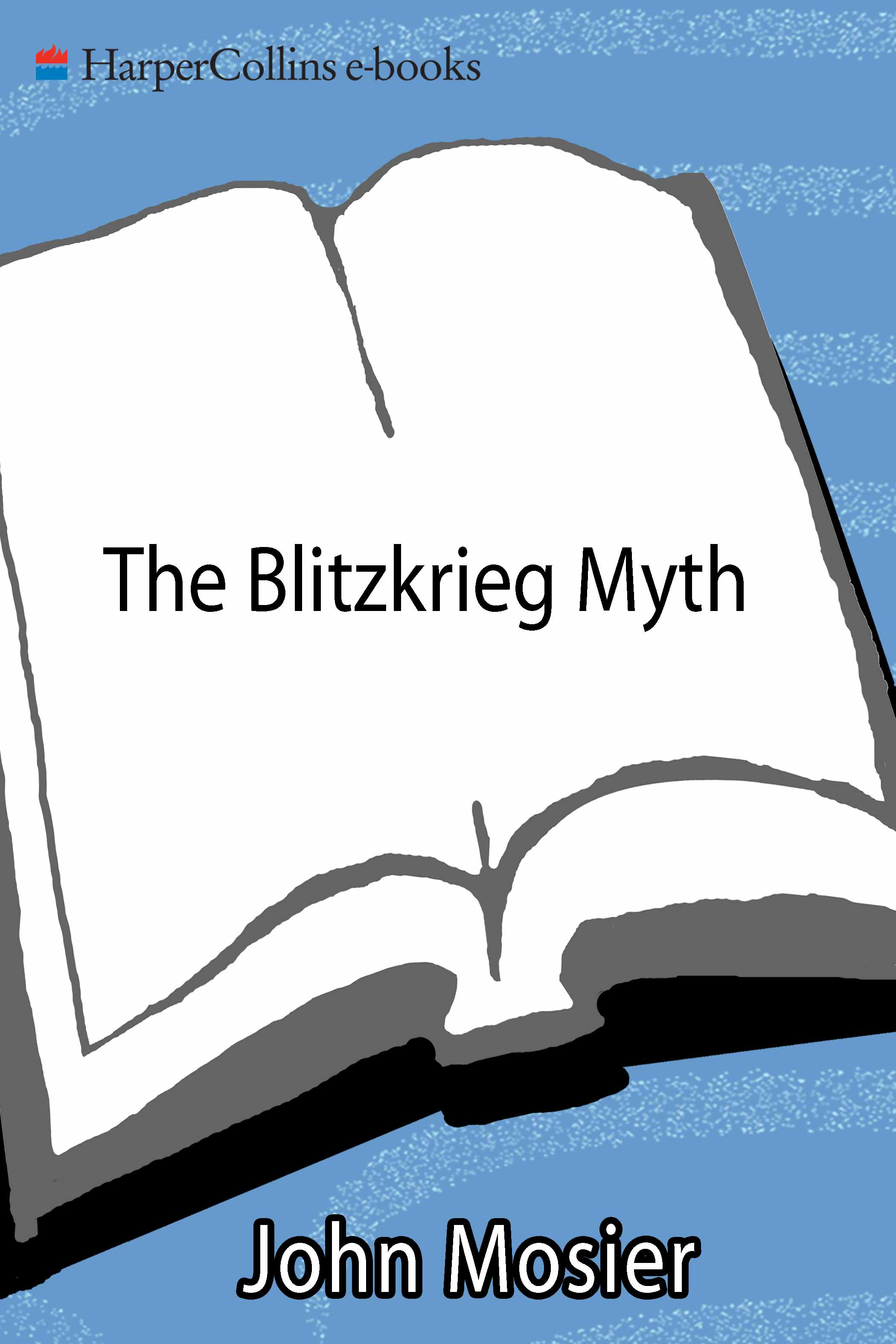
Men prefer one great lie to a mass of small truths.
ALEXANDER PUSHKIN
Contents
Their ideas are prefabricated. Experience teaches them nothing.
ALBERT SCHWEITZER
T his book, the result of a quarter century of research and reflection, demonstrates that traditional accounts of the Second World War are seriously flawed. The fundamental error is this: in the 1920s two new theories of warfare were postulated, most notably by the English armored officer J. F. C. Fuller and the Italian aviator Giulio Douhet. Over the course of the next decades these theoriesor their key portionswere adopted almost universally by military and political leaders and by historians and military analysts. The resulting ideas, identified as Blitzkrieg and airpower, are now universally accepted, not merely as important concepts in modern warfarewhich they certainly arebut as assumptions defining how the war was fought and why one side was successful and the other not. Douhet and Fullerand their apostlesreworked the evidence to support their arguments. As this book explains, their ideas were mostly incorrect, but all accounts of the Second World War accept their assumptions.
Although both Douhet and Fuller pretended to be rigorous and scientific theorists, their ideas, far from being borne out by what happened in the First World War, are almost completely contradicted by it. It follows, therefore, that those historians who have accepted their ideas as holy writ give a highly misleading picture of the war.
Not as to the actual outcomes: in this regard the Second World War is entirely different from the First, whose results were at bottom paradoxical and inconclusive. In an earlier book I argued that the military lessons of the Great War were mislearned. The Allies were largely ineffective militarily, the Germans largely victorious, even though they ultimately lost the war. In this book my critical focus is on the reasons given for the various defeats and victories, since the end results are clear: During 1939 and 1940, seven nations officially admitted their defeat by Germany; in May 1945 Germany officially admitted its own defeat and surrendered. Its cities were in ruins, its national territory occupied. There is no ambiguity there at all. The problem arises when we begin to consider how these defeats came about. My argument is that evidence demonstrates that these defeats were not primarily the result of new ideas about warfare but the result of traditional factors: politics and strategy.
The implications of this argument are fundamental for military history. It is almost universally accepted, for example, that the construction of the Maginot Line was an exercise in near futility that revealed the defeatist, retrograde thinking of the French. However, the facts reveal this to be a misperception of the realities of the 1920s and the 1930s. During the 1930s German military engineers presided over the construction of elaborate and extensive defensive positions, both east and west, almost exactly comparable to what the French had planned the decade before. Surprisingly little is known about the nature and extent of these fortifications, whose details (for the eastern frontier) did not begin to emerge until after the collapse of Communist Poland.
The assumption that the Maginot Line was uniquely French, and that it tells us something about France, is simply not true. The evidence shows that the Germans went through the same discussions the French did, that Hitler himself took a keen interest in what was being built, and that one of the key officers involved, a young major on the newly reformed general staff, was none other than Erich von Manstein, generallyand correctlyregarded as one of the Wehrmachts most successful commanders and the alleged architect of some of its greatest offensive victories. To understand what happened in this war, one must begin with an explanation that embraces the facts as they are known to exist, not as several generations of analysts have wished them to be.
The other point made by this book is no less fundamental: That is the argument that the airpower theories of men like Douhet, and the Blitzkrieg theories of men like Fuller, are at bottom the same thing, the difference being only in the mechanism used (tanks as opposed to planes). Both proposed to strike directly into the heart of the enemy, to win the war in one swift and decisive stroke. For want of a better term, I have employed the word breakthrough to describe this idea, which came to dominate both the direction of the war and what has been written about it since.
The point of this book is that accounts of this war, as of the one preceding it, are based on a slowly collapsing paradigm that is riddled with anomalies and contradictionstoo dependent on the suppression of evidenceto be accepted as a satisfactory explanation of the phenomenon itself. British historians of the First World War produced a gripping and absorbing account of how the war was won. The only thing wrong with it was that little of it was actually true. Through repetition they came to think that it was true, and to explain away any evidence to the contrary by mystifying the facts and hiding primary causes in a forest of secondary ones. In the Second World War partisans of national interest have largely (although in the United States not entirely) been replaced by adherents of the two theories, but the end result is the same sort of tale with all the same problems: It makes for a gripping story, but most of it isnt true.
The basic ideas of my narrative are simple, although its implications are not. The structure is divided into three parts: The first explains what these new theories of warfare were, and shows why they were largely, although not entirely, incorrect. The second explains how the two chief European powers, France and Germany, prepared for a future war. Not by devoting their defense budgets to tanks and planes but by building fortifications. The third, by far the longest section, reexamines the campaigns of the war in Western Europe in the light of what the first two sections establish as the historical truth.
In researching my earlier book on the Great War, I noticed two significant facts: first, that German losses in combat were substantially lower than those of their adversaries, generally in the neighborhood of two and even three to one; and second, that most of the casualties in the war were caused not by rifle bullets (as had been the case in all previous modern wars), but by shellfire from guns. These two facts led me to an investigation of German artillery, since it appeared that here was one important reason for the casualty imbalance.
By their very nature the instruments of modern warfare are complex technical devices. Yet without understanding the why and how of their basic functions, one can hardly judge the theories of their use that dominated military thinking in the decades before 1940. The old clich that those who do not understand history are doomed to repeat it is nowhere more applicable than in the study of warfare in this century. That alone justifies the necessity of combining the technical and the general, the practical and the theoretical, so that this account of combat in the Second World War goes beyond a simple recitation of the conventional wisdom on the subjectfor, as we shall see, at every turn the conventional wisdom is hardly sustained by what actually happened on the battlefield.
After 1942 the Germans, having enjoyed absolute air superiority in their earlier campaigns, failed signally to appreciate the realities of armored warfare without it. Their technical expertise in one area blinded them to the underlying reasons for their own success, a theme that this book expounds on at length. None of the specialists who planned for this war, or the military leaders who directed it once it began, seems to have had any real sense of the events that had gone before. Thus we find Patton, far and away the most literate and historically astute of all the major commanders, completely bogged down in precisely the same theater of operationsLorrainein which he had fought in the First World War. Of all the senior allied commanders, he should by rights have been the most aware of the difficulties involved in dislodging German infantry from fortifications.
Next pageFont size:
Interval:
Bookmark:
Similar books «The Blitzkrieg Myth»
Look at similar books to The Blitzkrieg Myth. We have selected literature similar in name and meaning in the hope of providing readers with more options to find new, interesting, not yet read works.
Discussion, reviews of the book The Blitzkrieg Myth and just readers' own opinions. Leave your comments, write what you think about the work, its meaning or the main characters. Specify what exactly you liked and what you didn't like, and why you think so.


